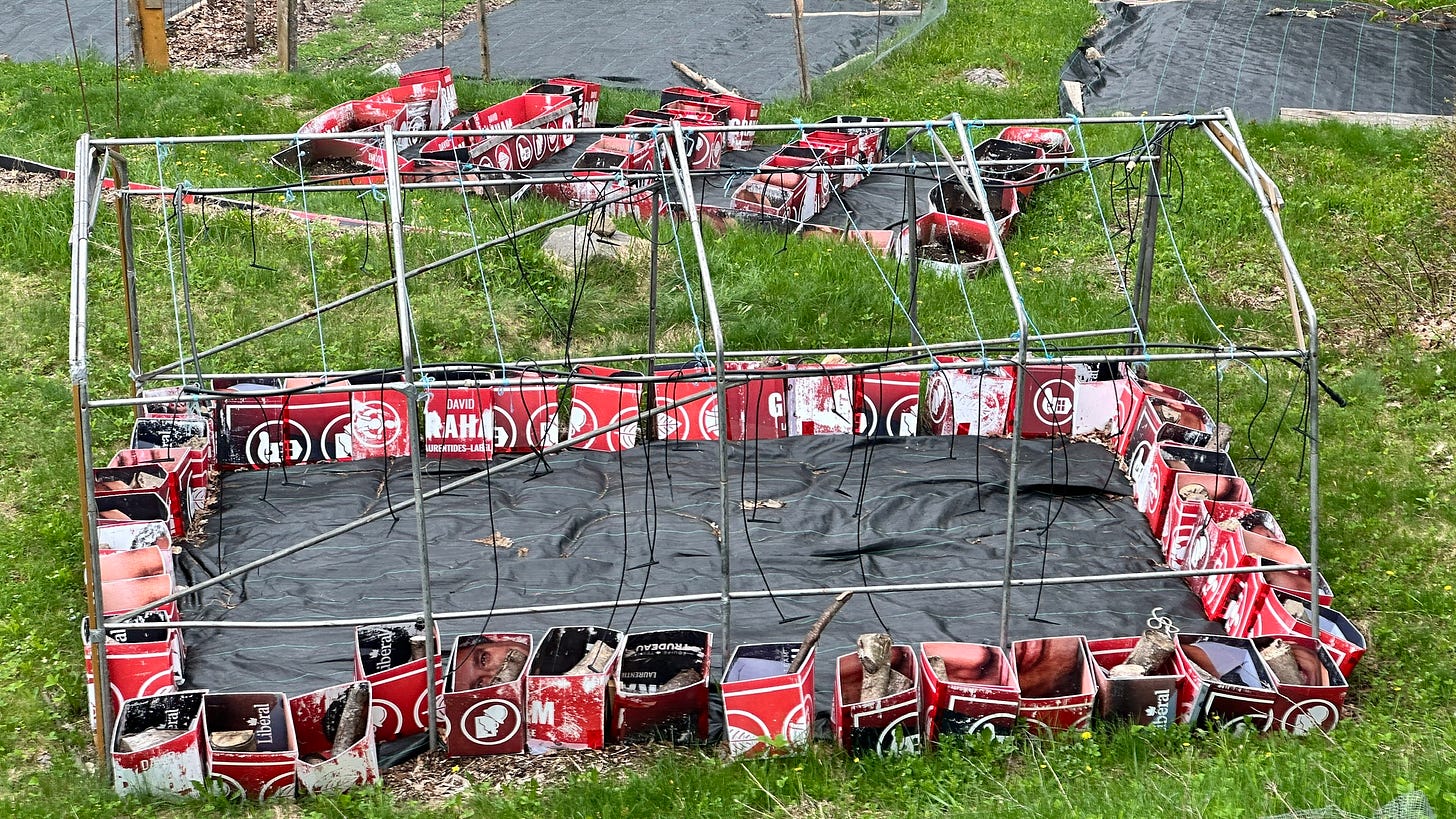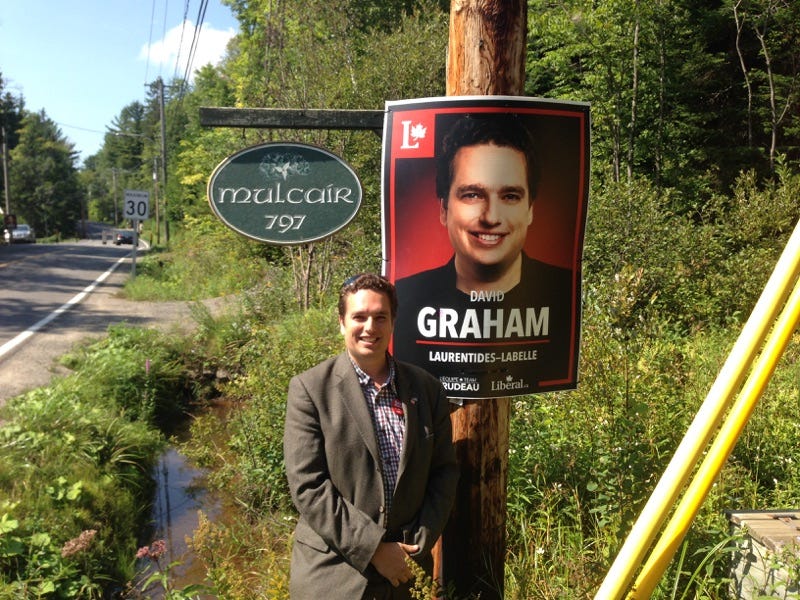Let's End Campaign Signs
One of the bizarre rituals of election campaigns is the campaign sign. It is the wasteful environmental catastrophe practiced by candidates and parties of all stripes in which pieces of difficult to recycle layered plastic are inked, put on posts, stakes, fences, sandwich boards, and anywhere else they can be stuck, and driven in cars, trucks, and trailers all over the country to be installed in every conceivable visible location, only to be removed a couple of weeks later never to be seen again. Some are recycled, some are reused, some are just lost in swamps and forests and medians. There must be a better way.
Five and a half years after my last campaign, I still have close to a thousand signs in different shapes and sizes stored on the pallets on which they were originally delivered behind my parents’ chicken coop. They’re not likely ever to be used in an election campaign again, but they’re endlessly useful around the property.
My parents, having spent years in real estate, had just run out of their old plastic for sale signs when I ran in 2015, and so the Coroplast replenishment was welcome in making things like garden boxes and rain covers for the birds.
After the 2015 campaign, my main opponents and I agreed to take down each other’s signs and save a lot of driving for all of us and our teams. Neither the NDP nor Bloc candidates wanted their signs back and simply asked me to dispose of the ones of theirs I acquired in the process. Teachers reached out to me for old signs to use in art classes and we gave them away by the hundreds. Thousands of signs went to landfill.
I intended to keep my 2015 signs for reuse in the 2019 campaign. Having done most of my campaigns as a volunteer in Ontario, where signs are often reused election after election, the whole idea that I would not reuse my signs the next time around seemed kind of ridiculous and wasteful. Having put up faded “Team Martin” signs as a campaign sign installer in Ottawa in 2011, more than 7 years after Paul Martin’s last campaign, I understood that what mattered was the party colour and the candidate’s name, not the age of the sign.
Shortly after I won in the 2015 campaign, I stopped to pick up a hitchhiker in the north of my riding along highway 117, as I often did as I traveled around as it was another way to meet people, and he asked me for a lift home which was in the same general direction as I was headed. His house was on a secondary road I’d driven many times near Rivière-Rouge, and when we got there I found dozens if not hundreds of campaign signs from all parties, though mostly mine, visible under the porch. He said he was using them for art projects and asked for some of the ones I had in my trunk as well. I winced a little, declined to give him any more, and wished him good luck with his art.
We only had a few hundred signs in the first campaign, and we only recovered about a third of them. The scheduled general elections in October coincide with moose hunting season in the Laurentians and, as October gets going, so do the signs. The strong but flexible plastic material is excellent insulation and project material for hunting cabins and lookouts and disappears quickly if not recovered.
Many signs are also taken down and thrown into ravines or ditches by people who do not support the candidate whose name is on the sign, and so the sign wars also entail a lot of maintenance to replace and repair missing or damaged signs.
Some parts of the sign war are more good-natured than others. A couple of days after the NDP candidate placed a Mulcair sign in front of Marc Garneau’s campaign office, I put a sign on the utility pole in front of a house belonging to the family of then-NDP leader Tom Mulcair.
For the next several weeks, my campaign office would receive regular phone calls letting us know if the Mulcair family garbage bin, which migrated in front of that pole shortly after our visit, was up, blocking my sign, or down, showing it, providing a source of entertainment for the team and partisans on both sides in that neighbourhood.
Placing campaign signs on lawns is common in most of Canada, but in Quebec placing a sign on your lawn is to advertise your allegiance, which is not as accepted culturally, and so it is one of few places where campaign signs are not only permitted, but encouraged, to be placed on public utility poles. Provincial ballots in Quebce include photos of the candidate as part of the general dumbing down of our democracy, so campaign signs in Quebec tend to feature the candidate’s photo over other information.
The Liberal campaign made a big show about the obviously Time Magazine-inspired campaign signs across the province, and the party had used a marketing agency to take the photos and create the signs. In 2019, we had a different standardised template that we were all meant to use. The 2019 signs were, in my view, absolutely atrocious. I put my 2015 signs back out, refreshing them with a sticker adding the slogan I’d been using since I first ran, and found myself in a fight with the party over the right to use the old signs, which party administrators told me was “illegal,” which, given that we had accounted for them in our campaign financial statements in both 2015 and 2019 was clearly false. I also ignored the party’s ugly signs and ordered simple small signs stating only my name and slogan “from here, for here” by the thousands for use around the riding.
The party expected all the 2015 signs to be disposed of and new ones used. The other parties did not run any of the same candidates against me and all of their signs were also new. The result was massive quantities of plastic signs of all colours that would be used for only a few weeks, then once again disposed of.
In the election that ended last month, there were nearly 2,000 registered candidates across the country. Even if they had an average of only 150 signs each — that is nearly 300,000 plastic signs across Canada for a 5-week campaign period. When I asked a recent candidate’s team about returning the sign I had taken for my lawn, I was told to simply throw it out — that storing them costs more than printing new ones next time. It got me wondering, not for the first time, why we do this weird ritual.
Do campaign signs still matter? Can we not have a society engaged enough to know that an election is happening without the visuals of plastic-sign-mushrooms blooming? Do we need to see plastic signs on street corners and people’s lawns to gauge support and decide how to vote? Can we, collectively, say it’s time to end plastic campaign signs? Could we, perhaps, vote on a more substantive basis than who has the prettiest face or the best or most signs?
Or is it really that important that we throw out at least a quarter million ultimately single-use plastic signs in every election cycle?








Time is on my sign, yes it is!
More seriously, I still appreciate your "from here, for here" slogan. What are the chances that someday you will add "back here"?
The good news is that you've now gotcm every squirrel and bird in Ste Lucie voting for you should you run again...